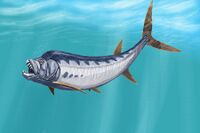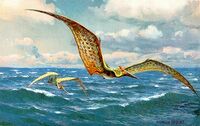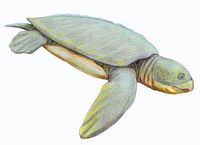Earth:Mooreville Chalk
| Mooreville Chalk Stratigraphic range: Upper Cretaceous | |
|---|---|
| Type | Geological formation |
| Unit of | Selma Group |
| Sub-units | Arcola Limestone Member |
| Underlies | Demopolis Chalk Formation |
| Overlies | Eutaw Formation |
| Lithology | |
| Primary | Chalk |
| Location | |
| Region | Alabama, Mississippi |
| Country | United States |
The Mooreville Chalk is a geological formation in North America, within the United States states of Alabama and Mississippi, which were part of the subcontinent of Appalachia. The strata date back to the early Santonian to the early Campanian stage of the Late Cretaceous.[1] The chalk was formed by pelagic sediments deposited along the eastern edge of the Mississippi embayment. It is a unit of the Selma Group and consists of the upper Arcola Limestone Member and an unnamed lower member.[2] Dinosaur, mosasaur, and primitive bird remains are among the fossils that have been recovered from the Mooreville Chalk Formation.[1][2][3]
Fish
Cartilaginous fish
| Cartilaginous fish of the Mooreville Chalk Formation | ||||||
|---|---|---|---|---|---|---|
| Genus | Species | Location | Stratigraphic position | Abundance | Notes | Images |
|
C. appendiculata[3] |
||||||
|
C. mantelli[3] |
||||||
|
E. barberi[4] |
||||||
|
E. mirificus[4] |
||||||
|
I. williamsae[4] |
||||||
|
O. cuspidata |
||||||
|
Propenser |
P. hewletti[4] |
|||||
|
P. mammillaris[4] |
?Neoselachian incertae sedis | |||||
|
P. mortoni[3] |
||||||
|
P. polygyrus[4] |
||||||
|
P. affinis[4] |
||||||
|
P. laevis[3] |
||||||
|
S. serrata[3] |
||||||
|
S. rhaphiodon[4] |
||||||
|
S. texanus[3] |
||||||
|
S. falcatus[4] |
||||||
|
S. kaupi[3] |
||||||
Bony fish
| Bony fish of the Mooreville Chalk Formation | ||||||
|---|---|---|---|---|---|---|
| Genus | Species | Location | Stratigraphic position | Abundance | Notes | Images |
|
A. dunklei[4] |
An albuliform |
|||||
|
B. crieleyi[4] |
A tselfatiform | |||||
|
C. nepaholica[4] |
||||||
|
E. petrosus[4] |
||||||
|
E. saevus[4] |
||||||
|
Hoplopteryx sp.[4] |
||||||
|
I. ctenodon[4] |
||||||
|
M. hardi[4] |
An elopiform | |||||
|
P. caninus[4] |
An elopiform | |||||
|
S. leanus[4] |
||||||
|
S. apicalis[4] |
||||||
|
X. audax[4] |
||||||
Reptiles
Dinosaurs
Indeterminate hadrosaurid, nodosaurid, dinosaur egg, and ornithomimmosaur fossils are known from Mooreville Chalk outcrops in Alabama.[1]
| Dinosaurs reported from the Mooreville Chalk Formation | ||||||
|---|---|---|---|---|---|---|
| Genus | Species | Location | Stratigraphic position | Material | Notes | Images |
|
A. antecessor |
A. antecessor was originally described as Plegadornis antecessor, but the generic name Plegadornis was preoccupied, so the genus Angelinornis was erected to contain the species. It was later demonstrated that Angelinornis was a junior synonym of Ichthyornis, although the new combination I. antecessor was held to be valid for a while following the sinking of Angelinornis into Ichthyornis. Later the species would later be considered a junior synonym of the Ichthyornis type species, I. dispar.[1] |
|||||
|
Eotrachodon[5] |
E. orientalis |
|
A hadrosaurid known from a nearly complete skeleton and nearly complete skull. | |||
|
"Vertebrae and limb elements."[6] |
An enantiornithine | ||||
|
I. antecessor |
The species I. antecessor was made the type species of the genus Angelinornis in 1962. Later, I. antecessor and Angelinornis were shown to be junior synonyms of the Ichthyornis type species, I. dispar[1] | |||||
|
An ichthyornithine. | |||||
|
A primitive species hadrosaurid known from only a few skull fragments.[1] | |||||
|
Plegadornis |
P. antecessor |
The name Plegadornis antecessor was applied to a fossil believed to represent a new bird species, but the generic name Plegadornis was preoccupied, so the genus Angelinornis was erected to contain the "new" species. It was later demonstrated that Angelinornis was a junior synonym of Ichthyornis, although the new combination I. antecessor was held to be valid for a while following the sinking of Angelinornis into Ichthtyornis. Later the species would later be considered a junior synonym of the Ichthyornis type species, I. dispar.[1] | ||||
Mosasaurs
| Mosasaurs of the Mooreville Chalk Formation | ||||||
|---|---|---|---|---|---|---|
| Genus | Species | Location | Stratigraphic position | Abundance | Notes | Images |
|
Clidastes |
C. liodontus[4] |
Mosasaurines |
||||
|
C. "moorevillensis"[3] |
||||||
|
C. propython[4] |
||||||
|
A halisaurine E. sternbergii was formerly classified as Halisaurus sternbergii | ||||||
|
E. zangerli [8] |
||||||
|
Globidens |
G. alabamaensis[3] |
A mosasaurine | ||||
|
M. missouriensis[3] |
A mosasaurine | |||||
|
P. tympaniticus[3] |
A plioplatecarpine | |||||
|
P. rapax[4] |
Mosasaurines | |||||
|
P. solvayi[3] |
||||||
|
S. russelli[3] |
A plioplatecarpine | |||||
|
T. proriger[4] |
A tylosaurine | |||||
Plesiosaurs
| Plesiosaurs of the Mooreville Chalk Formation | ||||||
|---|---|---|---|---|---|---|
| Genus | Species | Location | Stratigraphic position | Abundance | Notes | Images |
|
Trinacromerum |
Trinacromerum sp.[3] |
Polycotylids |
||||
Pterosaurs
| Pterosaurs of the Mooreville Chalk Formation | ||||||
|---|---|---|---|---|---|---|
| Genus | Species | Location | Stratigraphic position | Abundance | Notes | Images |
|
Pteranodon sp.[3] |
||||||
Turtles
| Turtles of the Mooreville Chalk Formation | ||||||
|---|---|---|---|---|---|---|
| Genus | Species | Location | Stratigraphic position | Abundance | Notes | Images |
|
B. barberi[3] |
A pelomedusid. |
|||||
|
C. haliniches |
A dermochelyid. | |||||
|
P. gigas[3] |
A protostegid. | |||||
|
T. moorevillensis[3] |
A toxochelyid. | |||||
See also
- List of dinosaur-bearing rock formations
- List of fossil sites
References
- ↑ 1.00 1.01 1.02 1.03 1.04 1.05 1.06 1.07 1.08 1.09 1.10 1.11 1.12 1.13 1.14 1.15 Weishampel, David B; et al. (2004). "Dinosaur distribution (Late Cretaceous, North America)." In: Weishampel, David B.; Dodson, Peter; and Osmólska, Halszka (eds.): The Dinosauria, 2nd, Berkeley: University of California Press. Pp. 574-588. ISBN:0-520-24209-2.
- ↑ 2.0 2.1 2.2 2.3 2.4 2.5 Chiappe, Luis; Lamb, James P.; Ericson, PER G. P. (2002). "New enantiornithine bird from the marine Upper Cretaceous of Alabama". Journal of Vertebrate Paleontology 22 (1): 170–174. doi:10.1671/0272-4634(2002)022[0170:NEBFTM2.0.CO;2].
- ↑ 3.00 3.01 3.02 3.03 3.04 3.05 3.06 3.07 3.08 3.09 3.10 3.11 3.12 3.13 3.14 3.15 3.16 3.17 3.18 3.19 3.20 3.21 Kiernan, Caitlin R. (2002). "Stratigraphic distribution and habitat segregation of mosasaurs in the Upper Cretaceous of western and central Alabama, with an historical review of Alabama mosasaur discoveries". Journal of Vertebrate Paleontology 22 (1): 91–103. doi:10.1671/0272-4634(2002)022[0091:SDAHSO2.0.CO;2].
- ↑ 4.00 4.01 4.02 4.03 4.04 4.05 4.06 4.07 4.08 4.09 4.10 4.11 4.12 4.13 4.14 4.15 4.16 4.17 4.18 4.19 4.20 4.21 4.22 4.23 4.24 Applegate, Shelton P.; Dale E. Russell (1970). The Vertebrate Fauna of the Selma Formation of Alabama. Part VII. Part VIII. The Mosasaurs The Fishes. Chicago: Field Museum of Natural History. pp. 387–430. OCLC 50419737. https://archive.org/stream/vertebratefaunao38appl/vertebratefaunao38appl_djvu.txt.
- ↑ Albert Prieto-Márquez, Gregory M. Erickson & Jun A. Ebersole, 2016, "A primitive hadrosaurid from southeastern North America and the origin and early evolution of ‘duck-billed’ dinosaurs", Journal of Vertebrate Paleontology DOI:10.1080/02724634.2015.1054495
- ↑ "Table 11.1," in Weishampel, et al. (2004). Page 213.
- ↑ "A new species of Halisaurus from the Late Cretaceous phosphates of Morocco, and the phylogenetical relationships of the Halisaurinae (Squamata: Mosasauridae)". Zoological Journal of the Linnean Society 143 (3): 447–472. 2002. doi:10.1111/j.1096-3642.2005.00152.x.
- ↑ https://www.academia.edu/3725966/The_relationships_of_Alabama_halisaurine_mosasaurs

















